You’re thinking of getting a puppy.
You’re an active type and you think a border collie might provide the intelligence and energy you want in your canine companion.
Besides, they’re pretty cute.
You’re probably picturing a fluffy back and white puppy that will grow into a slim dog with silky hair and pretty markings – not to mention those expressive ears!
When you look closely, you’ll realize border collie ears come in all shapes and sizes, from completely floppy (dropped) to completely erect (pricked) and everything between.
Next, you’ll probably wonder if your puppy’s ears will stay up or down.
How can you tell if a border collie’s ears will stay up or down?
All young puppies start off with floppy ears. In breeds that traditionally have pricked ears, the ears usually start to feel firm by four to six weeks and should be fully standing by five to six months. If they are still floppy at nine months, then they will likely stay that way.
What Kind of Ears Will My Border Collie Have?
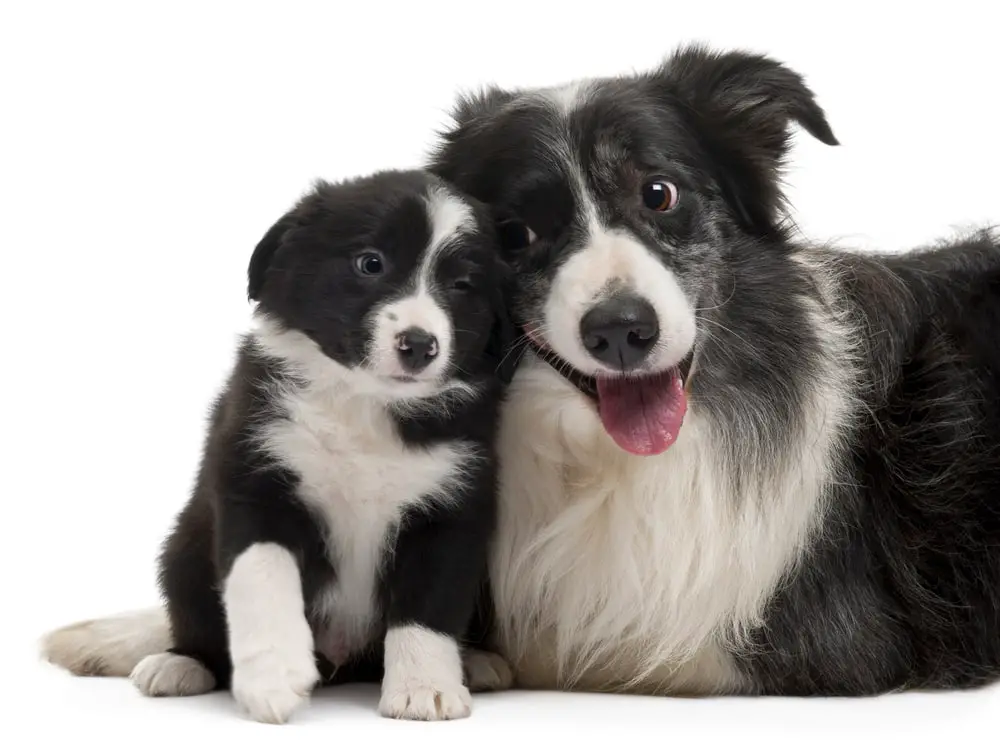
It’s easy to see how some dogs’ ears will turn out: you’d be surprised if your German shepherd didn’t end up with pricked ears.
But border collie ears are more difficult to predict because they come in so many shapes and sizes.
As your puppy goes through ‘teenagehood’ from around six months, his body will experience all kinds of awkward changes.
Teething especially can make his ears change direction, almost daily, until they settle into their adult shape (source).
The final shape of your dog’s ears is guided by a combination of genetic and environmental factors that can’t always be gamed out, but there may be a few clues along the way (source).
- Look at your puppy’s parents to get an idea of what shape his ears will take, although there’s no guarantee he’ll look exactly like mom and dad later in life.
- At two or three months, your puppy’s ears may stand when he is excited. This might indicate that his ears will be pricked or partly pricked as an adult.
- Ears set higher and closer on the head are more likely to prick. Lower-set and heavier ears are more likely to drop. Heavily fringed ears may also stay floppy.
A Brief History of the Border Collie
Renowned for its intelligence and agility, the border collie breed was developed in the late 19th and early 20th century Britain as a working dog herding livestock.
It was distinguished from dogs that had worked with farmers and shepherds in Britain for hundreds of years but were not considered purebred (source).
The name border collie refers to the border regions between England and Scotland where this type of collie originated.
It was coined in 1915 to distinguish working border collies from their cousins, the rough and smooth-haired collies, which were already being bred for the show (source).
Border collies gained immediate popularity and were soon exported around the world as working dogs, especially farming communities in Australia and America (source).
The breed has been popularized by movies like Babe, and today, border collies are in demand as pets and participants in canine sports (source).
Judging the Border Collie: Breed Standard Versus Working Performance
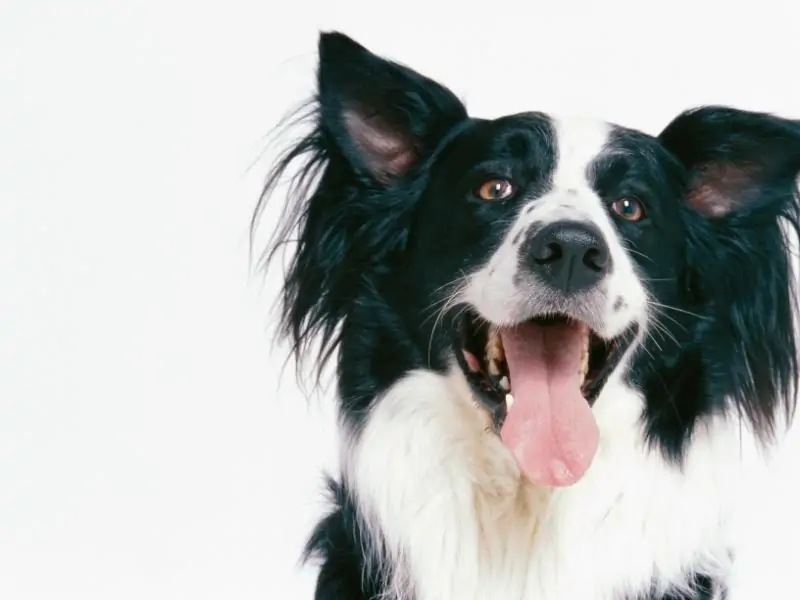
All border collies bear a strong resemblance to each other – you’re never going to confuse one with a Dalmation or a Labrador.
But there’s actually more variation in appearance from dog to a dog than most ‘pure’ breeds allow.
For a start, border collies don’t come only in black and white: they can be tricolor (black, white and brown), white, red, sable or even brindle.
Even their coats vary, from short and ‘smooth’ to longer and ‘rough’ (source).
For most of its history, there was no breed standard for the border collie, which explains the variety in appearance of even purebred border collies today.
The breed standard is the set of guidelines dictating how an ‘ideal’ breed specimen should look (source).
Dogs are judged according to how well they conform to the breed standard, usually at shows where breeders select winning dogs in the hopes that their puppies will inherit their ‘desirable’ genes.
As a working dog, the border collie was never bred for a particular appearance.
For most of the 20th century, it was classed among a mixed bag of ‘working dogs’ and wasn’t eligible for conformation showing.
Instead, these dogs are traditionally judged by their performance in trials of agility and obedience (source).
Think of the sheep trials featured in the classic children’s novel, Babe the Sheep-Pig, better known in its movie adaptation, Babe.
In these trials, dogs move a flock of sheep around an enclosure according to signals given by their shepherd.
The speed and interactive nature of the competition couldn’t be more different from a conformation show.
In these trials, judges look for indications that a prize border collie is intelligent, athletic, enthusiastic, and responsive to commands.
The dog should be capable of both speed and endurance, be able to change direction quickly, and demonstrate an intense focus on the livestock without instilling fear (source).
Becoming a member of the American Kennel Club
The American Kennel Club (AKC) included the border collie in the Miscellaneous Class until as recently as 1995 when it finally recognized the breed for show purposes.
Conformation showing of border collies began the same year.
Around the world, there has been a gradual shift in focus from the breed’s working abilities to its conformation to a breed standard appearance.
The change has not come without opposition from groups seeking to protect its status as a pure working dog, and those innocent puppy ears that stole your heart are at the center of the controversy.
Border Collie Ears: The Basics
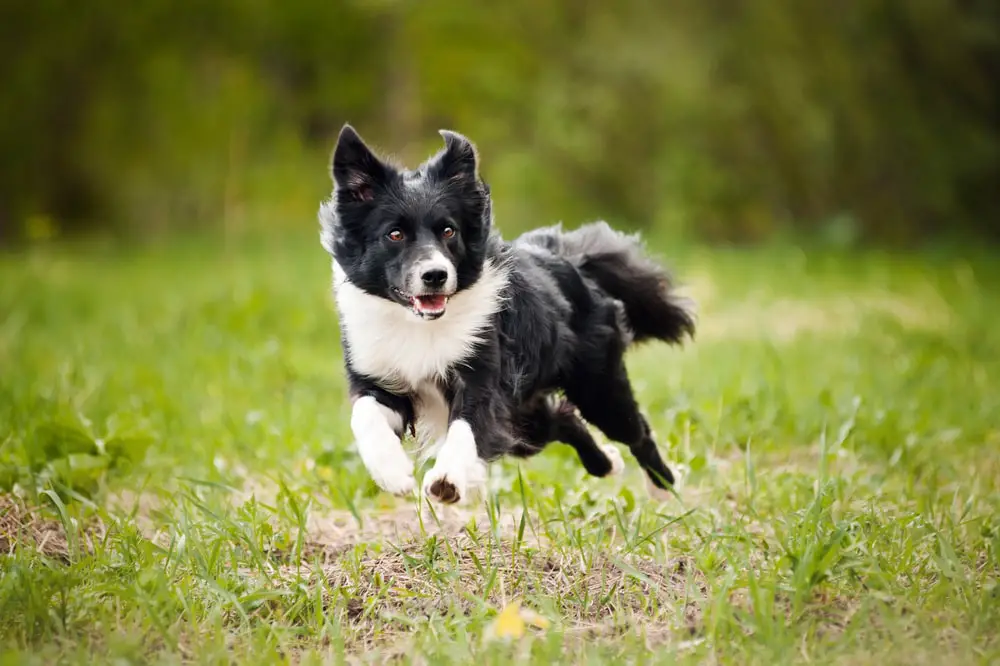
All dogs have the same basic ear anatomy, made up of the outer, middle and inner ear.
The outer ear comprises the soft furry ear flap (the pinna), and the ear canal (source).
Dogs have much larger pinnae than humans and can move them to better capture sound.
The whole ear is well supplied with muscles, blood vessels, and nerves, helping dogs to hear many times better than we do (source).
A dog’s ear flaps are also a matter of fashion.
Every breed standard specifies the shape, position, and size of the ears.
But all this gets a lot more complicated when it comes to border collies.
Some have completely erect or completely dropped ears.
Many have tag ears, with a third of the ear standing erect while most of it tips forward.
Some have ‘airplane ears’ which fly cheekily sideways.
Many have one ear that looks different from the other, or ears that prick and relax according to the dog’s mood.
Research has shown a correlation between ear types and certain gene variants in dogs (source).
The variability of border collie ears may be due to the healthy mix of genes it brings from its days as a rural shepherd’s dog.
For many border collie lovers, ‘ear confusion’ is an endearing trait; in fact, the mobile and expressive quality of the ears is specifically mentioned in most border collie breed standards.
But as breeding border collies for show becomes more popular, many owners have become obsessed with achieving the ‘perfect’ ear.
Exacting Standards
The American Kennel Club’s breed standard states that a border collie’s ears should be well spaced and medium-sized.
It does not, however, specify any particular shape.
Instead, the ears may be either pricked or tipped (meaning anything between a quarter and three-quarters of the ear is erect, with the rest flopping over), and the tips may fall forward or sideways.
The AKC breed standard doesn’t even insist that a border collie’s ears should be perfectly symmetrical but says that one or both may be pricked or tipped. (source)
But spend any length of time on online forums and you’ll realize that the standard breeders expect their dogs to uphold is far more exacting.
The prevailing fashion is for perfectly symmetrical, tipped ears, were ‘tipped’ means three-quarters of the ear is erect, and the top quarter falls forward.
It’s a meticulous specification that has little to do with the formal breed standard and is almost impossible to expect nature to produce on her own.
This is why your puppy’s shaggy ears are the focus of a breed controversy.
The controversy
Fans of the border collie breed are divided into two broad camps: those who emphasize its role as a working dog, and those who encourage breeding for a standardized appearance.
Working border collie groups object to the imposition of a breed standard, fearing it will detract from the breed’s spectacular talent as a working dog, the very reason it was developed in the first place.
They insist it doesn’t matter whether the dog’s ears match or what shape they are. Many objected to the breed’s AKC recognition in 1995.
In fact, the American Border Collie Association (ABCA) refuses to register dogs that are registered with AKC regardless of their working talent (source).
The battle between the two camps can get ugly, especially because many owners turn to artificial means, ranging from the uncomfortable to the downright cruel, to give their dogs the ‘right’ appearance.
Rough Collie Ears
Short-haired smooth collies and the more familiar, longer-haired rough collie both share their ancestry and working origins with their border collie cousins.
But the collie became fashionable much earlier, popularized by Queen Victoria and the Lassie character. The collie was recognized by the AKC almost a century before the border collie, in 1885 (source).
Consequently, collies have been more intensively bred for showing.
The AKC breed standard for collies is a tipped ear with the uppermost quarter folded over.
Ears may not be too large or placed too high or too low on the head.
They may not be pricked.
Ears that aren’t correctly placed or shaped are considered unable to show true expression and are penalized (source).
In life, this standard of perfection is rare, and it is common knowledge that most show collies don’t display natural ear shape.
Correcting my Border Collie’s Ears
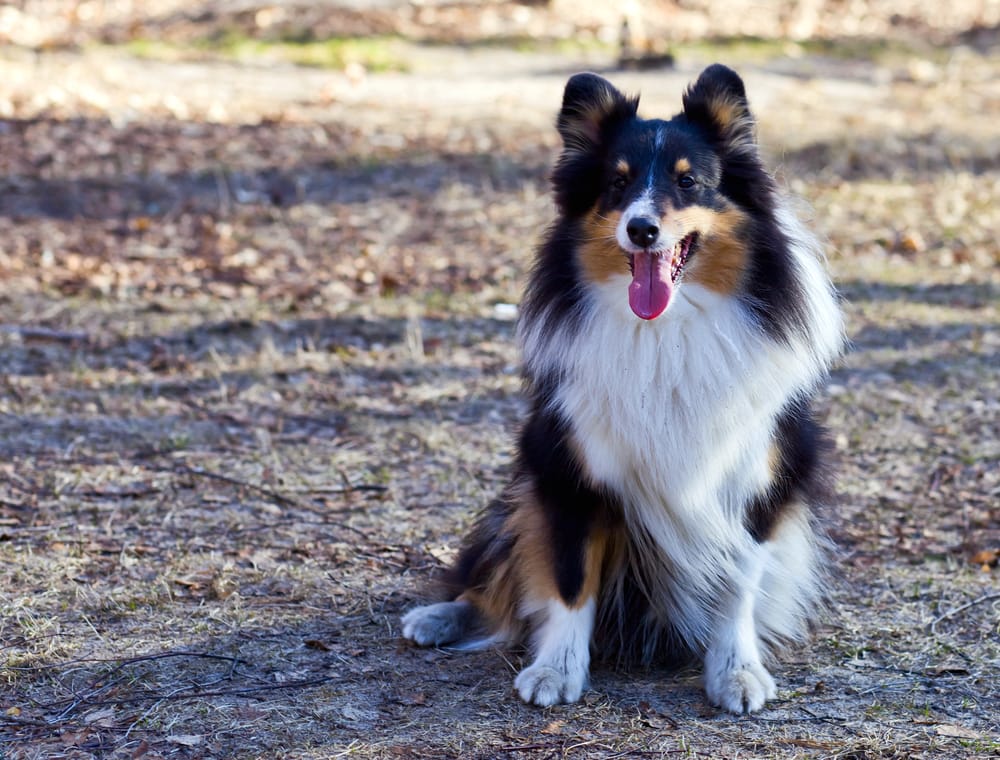
Many border collie and collie owners correct their dogs’ ears, whether they are floppy or pricked because while ‘perfectly’ tipped ears may be considered desirable, they’re far from common.
But the first question you should ask yourself is whether a correction is necessary.
Your priority should be your dog’s health, which means avoiding discomfort and pain, especially if they’re imposed for your vanity and not his well-being.
Breed standards are essentially a matter of fashion.
It’s widely acknowledged that taken to extremes they cause severe inbreeding and health defects (consider brachycephalic dogs such as pugs that struggle to breathe through their short, flat noses).
Many breeders brace or tape stubborn ears into adulthood, despite AKC regulations making it illegal to artificially alter a show dog’s appearance (source).
Like braces on human teeth, correcting your dog’s ears imposes an artificial shape on a natural feature, and won’t make him more likely to sire puppies with ‘perfect’ ears.
If you decide to correct your puppy’s ears, do it before he reaches 7 months, and before he finishes teething.
The process will take at least a few weeks because you are essentially ‘training’ his ears to retain the desired shape on their own.
Above all, remember that your dog’s ears are highly sensitive.
Do not cut off the circulation or do anything to cause him pain. This is both unnecessary and cruel.
How to Make my Border Collie’s Ears Stand Up
Your puppy’s ears look like they’re heading south. Here are some steps you can take to encourage them to develop a little more lift:
- Encourage your dog to strengthen the muscles at the base of his ears by chewing puppy-safe toys and chews purchased from a reputable pet shop or your vet.
- Avoid the temptation of rubbing your puppy’s ears too much, as this can break down and soften the cartilage. When your puppy is asleep, move his ear out from under his head to avoid the weight weakening the cartilage.
- Clip any excess hair that might weigh the ears down.
- Tape or brace them upright. See below for information on how to do this safely.
How to Make my Border Collie’s Ears Tip
If puppy’s ears are developing too much lift, and you’d like to encourage them to tip, you can try these suggestions:
Massage
Gently massage hand lotion or glycerin into the skin on the underside of your puppy’s ears, starting where the fold should be, and working towards the tip.
Use unscented, colorless lotions, and stop if you see any irritation.
Fold
Fold the ear tip and glue the hair at the tip to hair further down.
Some owners glue a small weight such as a sweet (which won’t harm your puppy if he swallows it) to the tip of the ear.
Do not use ordinary glue, but rather invest in specially formulated glue that won’t harm the skin.
Follow the product instructions carefully and stop if there’s any sign of irritation.
How to Tape my Border Collie’s Ears
You may have heard that taping is a painless, non-surgical way to achieve the ear shape you want.
The idea is to prop the ears in the desired position until the muscles become strong enough to hold them up.
There are two methods available to you.
Wrap
Wrap masking tape or similar around each ear from the base to about two-thirds of the way up, allowing the tip of the ear to fold over the tape.
Hold the ear upright and don’t roll or crease it vertically as you wrap.
Use tape to attach the ears across the front and back of the head to hold them higher and closer together.
Cut
Cut two identical oval-shaped supports from moleskin or similar stiff material.
Stick the templates to the insides of the ears, low enough to allow the tips to fold over.
Some breeders recommend using a Breathe Right strip.
Reapply the tape or brace every time it comes off in play or sleep.
Clean the inside of your puppy’s ear gently but thoroughly before and after application to ensure no sticky residue is left on his skin.
Ears are sometimes taped for health reasons – for example, if your dog gets a small injury in the fold of his ear, taping will help keep the wound dry.
But in most cases, taping is purely aesthetic, so it’s important to prioritize your dog’s well-being and avoid causing pain or distress.
Whatever method you choose, it will take a few weeks to work, and you’ll need to be patient with your puppy.
Remember, the process can be stressful and the tape might muffle his keen sense of hearing.
Here’s a short tip on how to set border collie ears to tip:
Border Collie Ear Health

Many purebred dogs are prone to health issues, and although border collies are considered to be a healthy breed, they have their share of inherited conditions.
They are prone to two types of hearing loss.
Early-onset deafness (EOD) is present at birth or develops in young puppies, while adult-onset deafness gradually sets in between 1 and 8 years (source).
Border collies are also prone to noise phobia (source), and abnormal ear shape may indicate disease, nerve damage, or a genetic defect.
Both early and adult-onset deafness are inherited, although neither is associated with any particular ear shape.
It’s thought that deafness occurs most often in dogs with all-white or mostly white coloring (source), where unpigmented skin in the inner ear causes nerve endings to atrophy and die off, resulting in deafness (source).
One study has suggested that the pattern of inheritance is autosomal recessive (source).
It’s common for breeders to euthanize deaf puppies, but it’s entirely possible for a deaf or partially deaf dog to live a full and happy life (source).
Taking Care of Your Border Collie’s Ears
As with any dog, it’s important to take care of your border collie’s ears.
Keep them clean but don’t reach into the ear canal as you might cause damage.
And, be careful not to get water inside his ears.
Check regularly for wax build-up, redness or foreign objects and especially if your dog is shaking his head or scratching his ears (source).
Food allergies can cause chronic ear infections, so feed him high-quality foods, avoiding artificial preservatives, flavorings, or food colorings.
For example, chicken allergies are quite common in dogs and can lead to chronic ear inflammation, among other side effects (source).
Avoid unnecessary risks by taking care to control what your dog eats.
For more information on what to do if your dog eats something that could harm him, read “My Dog Ate Fish Food”.
My Border Collie Holds his Ears Back: Is This Normal?
Having Googled a hundred pictures of perky border collie ears, you might be alarmed to realize that your dog’s ears are more often laid back along with his skull.
In fact, it’s common for border collies to hold their ears back in repose.
This shape even has a name: ‘rosebud’ ears.
But your dog’s ears are also a vital part of his body language and it’s important that you learn to read them.
Many dogs of various breeds lay their ears back when they are listening to the sounds around them, but ears pinned back against the head can be a sign of stress, especially if your dog is also holding his tail between his legs, breathing rapidly, tensing his muscles or trembling.
Related Article: Complete Border Collie-Maltese Mix Guide! Know everything about the breed!
Final Thoughts
Unless you aim for a career on the dog show podium, the best decision may be to leave your dog’s ears to grow naturally.
Enjoy their odd shapes as he ages, and take pleasure in his unique appearance.
Consider joining an online forum where fellow enthusiasts share pictures and stories of their dogs to foster an appreciation of the breed’s character.
A border collie’s ears are a delightful part of his unique emotional self-expression.
Whatever breed you choose when you get yourself a dog, remember that focusing on temperament and protecting his health are the best guarantees of a long, successful relationship.


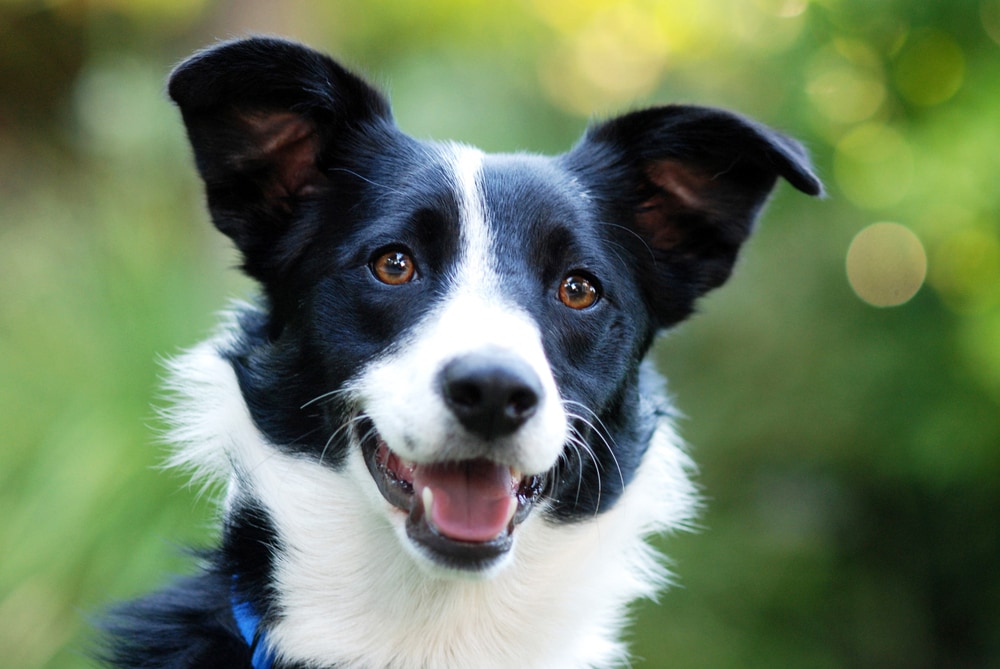
0 Comments